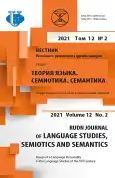РОДИНА-PATRIA in Russian and Spanish Verbal Associative Networks
- 作者: Sánchez Puig M.1
-
隶属关系:
- Complutense University
- 期: 卷 12, 编号 2 (2021): Image of a Language Personality in the Language Studies of the XXI Century
- 页面: 302-315
- 栏目: LANGUAGE PERSONALITY
- URL: https://journal-vniispk.ru/2313-2299/article/view/323379
- DOI: https://doi.org/10.22363/2313-2299-2021-12-2-302-315
- ID: 323379
如何引用文章
全文:
详细
The specific national characteristics of stimulus Homeland in Russian and Spanish verbal associative network are described in this article. The contrastive analysis of one of the basic word-model-points, inherent to the Russian and Spanish native speakers, is being investigated for the first time. The qualitative indicators of the performed analysis constitute a kind of thesaurus of the associative norms of the Russian and Spanish languages and, together with the quantitative ones, can be the subject of linguo-psychological comparative analysis and provide additional information about the associative norms, structure, linguistic ability and national character of the speakers of the given language and culture.The theme may be interesting for specialists not only in philology, but also in psychology, sociology, culturology, mass media, commercial advertizing and other spheres connected with human activity.
作者简介
M. Sánchez Puig
Complutense University
编辑信件的主要联系方式.
Email: mspuig40@gmail.com
Dr. Phil., full profesor of Russian philology. Complutense University. Dr. Honoris causa Russian Academy of Sciences
2, Avda. de Séneca, Ciudad Universitaria, Madrid, Spain, 28040参考
- Karaulov, Yu.N. (1987). The Russian language and linguistic personality. Moscow: Nauka. (In Russ.).
- Sanchez Puig, M., Karaulov, Yu.N. & Cherkasova, G.A. (2001). Associative norms of the Spanish and Russian languages. Moscow. (In Russ.).
- Karaulov, Yu.N. (1999). Active grammar and the associative-verbal network. Moscow: IRYa RAN. (In Russ.).
补充文件









